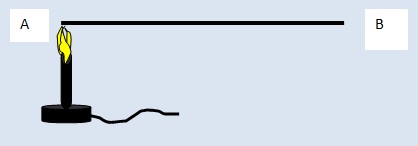Transfer of Heat
Activity A
Take an iron bar and place its one end A over the flame of candle and hold other end B in your hand.

Observation
In the beginning end B is not warm. After some time it gets warmer and warmer
If we touch the rod at different points along the length, we find that the nearer the point is to the end A in the flame the hotter the point
Conclusion
The Heat flows from the end A which is at a higher temperature to the end B which is at lower temperature without movement of particles.
From your school lab see the thermometer, Celsius and Doctor’s thermometer. Try to find out information about thermometers which measure very high temperatures and very low temperature.
Activity B
Place a vessel containing water over a flame.
Observation
Water at the bottom of the vessel is heated first and after some time the top surface of the water becomes war
Conclusion
Heat is transferred from the bottom to the top and to all part of the vessel.
Activity C
We sit near fire place or in the sun during the cold days
Deductions
Heat flows from a distant source to our body, even though the air around us may be cold.
Concept of Heat Transfer
Take a basket full of biscuits. Pass it in the class with the instruction that each student should pickup one biscuit and pass on the basket to the next student.
This is similar to the flow of heat in the iron bar A-B in the diagram of activity A above. This method of Transfer of transfer of heat is known as Conduction.
Now keep the basket on the table and ask the student to go to table and pick up one biscuit each.
This is similar to the flow of heat in water. This method of Transfer of heat is known as Convection.
Now one student stands near the basket and throws biscuit one by one to other students directly. This is similar to the transfer of heat from sun or the fire place to our body. This method of the transfer of heat is known as Radiation.
